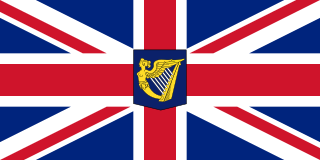
Lord Lieutenant of Ireland, or more formally Lieutenant General and General Governor of Ireland, was the title of the chief governor of Ireland from the Williamite Wars of 1690 until the Partition of Ireland in 1922. This spanned the Kingdom of Ireland (1541–1800) and the United Kingdom of Great Britain and Ireland (1801–1922). The office, under its various names, was often more generally known as the Viceroy, and his wife was known as the vicereine. The government of Ireland in practice was usually in the hands of the Lord Deputy up to the 17th century, and later of the Chief Secretary for Ireland.
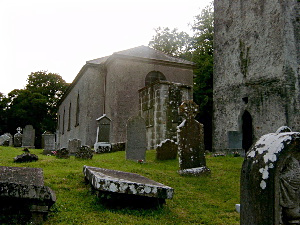
Ardbraccan is an ancient place of worship in County Meath, Ireland. It is the location of the former residence of the Roman Catholic, then, after the Reformation, the Church of Ireland Bishop of Meath. it was also a place of prominence in pre-Christian Pagan history. It is approximately 52 km from Dublin via the M3 Motorway, and 4 km from Navan. Ardbraccan is in a civil parish of the same name.
Bohermeen is a Roman Catholic parish in the Irish Diocese of Meath. Its English name is a corruption of an ancient Irish language name, An Bóthar Mín, which meant the smooth road. Originally one of the five famed ancient roadways that led from the mediaeval capital of Ireland, Tara, approximately 10 miles away cut through the area. The quality of the roadway, in an era of dirt-roads, earned for it the nickname of the smooth road, An Bóthar Mín.

Ardbraccan House is a large Palladian country house in the town of Ardbraccan, County Meath, Ireland. The historic house served from the 1770s to 1885 as the residence of the Church of Ireland Lord Bishop of Meath.

Trim Castle is a castle on the south bank of the River Boyne in Trim, County Meath, Ireland, with an area of 30,000 m2. Over a period of 30 years, it was built by Hugh de Lacy and his son Walter as the caput of the Lordship of Meath. The Irish Government currently own and are in charge of the care of the castle, through the state agency The Office of Public Works (OPW).
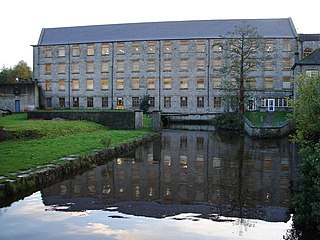
Celbridge is a town and townland on the River Liffey in County Kildare, Ireland. It is 23 km (14 mi) west of Dublin. Both a local centre and a commuter town within the Greater Dublin Area, it is located at the intersection of the R403 and R405 regional roads. As of the 2022 census, Celbridge was the third largest town in County Kildare by population, with 20,601 residents.
Allenstown House was a large five-bay, four-story Georgian mansion in County Meath, Ireland. It was built in around 1750 by William Waller.

Mornington House was the Dublin social season Georgian residence of the Earls of Mornington at 24 Merrion Street, close to Leinster House.
St. Ultan of Ardbraccan, also known as Ultan the scribe was an Irish saint and Abbot-Bishop of Ardbraccan during the 7th century. He died c. 657 and his feast day is celebrated on 4 September.

Boyerstown is a townland in County Meath, Ireland. It is located off the N51 national secondary road 5 kilometres (3 mi) southwest of Navan. The M3 motorway runs through the townland.

Ardgillan Castle is a country house near Balbriggan, County Dublin, Ireland. It is set in the 200-acre (0.81 km2) Ardgillan Demesne, a public park in the jurisdiction of Fingal County Council.
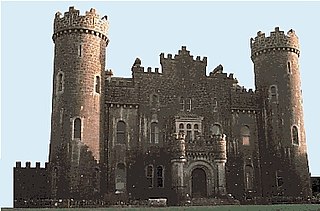
Clonyn Castle also known as Delvin Castle, is a Victorian country house situated in Delvin, County Westmeath, Ireland some 18 km from Mullingar along the N52. It is a square, symmetrical, two-storey castle-like building of cut limestone with four tall, round corner towers at each corner. The interior has a large two-storey hall with a gallery and arcading. It was one of the last Victorian baronial castles to be built in Ireland.

Dunsany Castle, Dunsany, County Meath, Ireland is a modernised Anglo-Norman castle, started c. 1180 / 1181 by Hugh de Lacy, who also commissioned the original Killeen Castle, nearby, and the famous Trim Castle. It is one of Ireland's oldest homes in continuous occupation, possibly the longest occupied by a single family, having been held by the Cusack family and their descendants by marriage, the Plunketts, from foundation to the present day. The castle is surrounded by its demesne, the inner part of the formerly extensive Dunsany estate. The demesne holds a historic church, a walled garden, a stone farm complex, and an ice house, among other features, and is home to a wide range of fauna.

Killeen Castle, located in Dunsany, County Meath, Ireland, is the current construction on a site occupied by a castle since around 1180. The current building is a restoration of a largely 19th century structure, burnt out in 1981.

Dardistown Castle is a castle and country house situated in parkland near Julianstown in County Meath, Ireland a few miles south of Drogheda.

Ashbourne is a town in County Meath, Ireland. Located about 20 km north of Dublin and close to the M2 motorway, Ashbourne is a commuter town within Greater Dublin. In the 26 years between the 1996 and 2022 census, the town tripled in population from approximately 4,900 to 15,680 inhabitants. The town is passed by the Broad Meadow Water, which comes from Ratoath and Dunshaughlin.
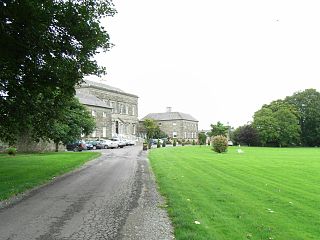
Bellinter House is a large classic country house of Georgian heritage which, in the early 21st century, was renovated and opened as a hotel and spa. It is in 12 acres of parkland beside the River Boyne in County Meath, Ireland, approximately 10 km from Navan.

Durhamstown, known less frequently as Dormstown, is a townland outside Navan in County Meath, Ireland. In religious terms it is covered by the Roman Catholic parish of Bohermeen. Durhamstown townland lies in the civil parish of Ardbraccan, and has an area of 1,025 acres (1.602 sq mi).

Liscartan, or Liscarton, is a townland and civil parish in County Meath, Ireland. It is about 3 miles (5 km) northwest of Navan, on the river Blackwater, and on the former mail road from Dublin to Enniskillen.


















